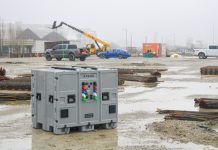Lafarge Canada has declared an ambitious goal of doubling Eastern Canada recycled aggregates volumes by 2025—a set target to supply customers with over 2 million tonnes per year.
The use of recycled aggregates alone is a key component of Lafarge Canada’s journey to Net Zero, directly associated with the global demand for sustainable building solutions to support better living standards.
RELATED: Lafarge Canada awarded for outstanding contribution to BC transportation
“2021 was a record year. Having achieved a 19 per cent growth rate last year exceeding our original ambition of 15 per cent, encourages our teams to confidently work towards our 2025 Aggregates Strategy,” commented Peter Sanguineti, Vice President, Aggregates Eastern Canada. “In fact, we are already looking to accelerate this year’s growth rate, aiming at 25 per cent – a 10 per cent annual prediction increase – based on our ongoing projects with key partners in Eastern Canada.”
“In addition, our high quality recycled aggregates significantly reduce the volume of virgin material to be transported by trucks over time,” commented Marie-Michèle Poirier, Manager, Environment & Land, Eastern Canada, “In order to reuse construction waste and turn it into recycled aggregates, we transport the waste directly to stockpiles at cities’ depots, which traditionally is a shorter distance compared to virgin material transportation from quarries to construction sites, resulting in a significant decrease in GHG emissions.”
“Our objective is to follow the circular economy’s three principles of Reduce, Reuse, and Recycle to build more with less and preserve our ecosystems. In that sense, our efforts are focused on expanding applications for recycled aggregates and raising quality and acceptance standards; and at the same time, address current barriers across Provincial and local governments,” affirms Sanguineti. “When you consider the logistics benefits of being close to the market and the need for a trusted outlet for demolition waste, we have a winning recipe.”
Partnerships in Eastern Canada
Over the past years, in Eastern Canada, Lafarge has supplied recycled aggregates to multiple projects in partnership with the Ontario Ministry of Transportation and the Infrastructure Ontario, including Metrolinx and the most recent QEW Credit River project.
In addition, lately, the company has been working with subcontractors to Mosaic’s Finch Light Rail Transit (LRT) project to supply recycled aggregates in Mississauga (ON).
According to Lafarge, these applications prove the versatility and high performance standards of its recycled aggregates portfolio in traditional applications.
“In one of our most recent endeavors, we have been supplying multiple contractor partners performing the work for the various projects as part of the City of Toronto Basement Flooding Protection Program,” affirms Mark Lambie, Commercial Manager, Greater Toronto Area Aggregates. “The City primarily uses recycled concrete for trench backfill and bedding as part of the roadwork and their Flood Protection Program upgrades to water and wastewater in infrastructure. This proves that with proper processes and controls in place to guarantee product specifications, quality and consistency in addition to proper traceability, it can be safely utilized in a much broader and complex range of applications.”
As part of the execution of Lafarge Eastern Canada Aggregates Strategy, the company has been also partnering with Concordia University, in Quebec, leading a study in cooperation with the City of Montreal to assess recycled aggregates performance in different applications.
“Another exciting channel is our collaboration with different industries’ interest groups, such as Circular Economy Leadership Canada (CELC) and our participation in their World Circular Economy Forum last year,” highlighted Sanguineti. “Lastly, in February this year, we had the pleasure to sponsor the ‘Maximizing the use of recycled aggregates for roads construction in Canada’, a national workshop led by Circular Economy Leadership Canada in partnership with Circular Innovation Council. The event was a great opportunity to share information amongst various industry stakeholders and further our common understanding of the success stories and remaining barriers.”
Technical and scientific studies
According to Nicolas Ginouse, Technical Director, Aggregates & Construction Materials, Eastern Canada, “Technical and scientific studies on this topic clearly show that the complete or partial replacement of virgin aggregates by recycled aggregates offers unique opportunities for supply chain security, reducing natural resources consumption, and global carbon footprint while ensuring similar, and in some cases, superior performances when compared to virgin materials. In some European countries and areas, such as in Paris, where sourcing virgin aggregates is very challenging, the use of recycled aggregates has become the norm, as they are essential to secure sustainable and cost-effective aggregates supply, while reducing CO2 emissions.”
In 2019, the Ontario Good Roads Association (OGRA) estimated that more than 6 million tonnes of Recycled Asphalt Pavement (RAP) were being stockpiled at over a hundred facilities across the province.
“If we were to reuse this amount of RAP as an industry—the equivalent of over 500,000 full dump trucks—in producing asphalt for new roads, we would be looking at saving around 15 million cubic metres of freshwater, enough water for over 50,000 households for one year, and on top of that, we would be saving 125 thousand tonnes of greenhouse gases (GHGs) emissions,” concludes Lambie.
Industry task force
There are currently a few barriers restricting the accelerated growth of recycled aggregates in Canada. One of the most pressing roadblocks is the lack of trust in performance—related to a few unfortunate events that took place in the past associated with industry players that have supplied projects with substandard material, which have resulted in quality and durability issues.
“This is why it is key for us to aim to define a set of regulations or a certification system that provides the minimum quality and consistency requirements to ensure high standard performance. However, Lafarge recognizes the fact that we cannot influence this on our own and there must be consensus among responsible players,” commented Sanguineti. “With that said, we have initiated an industry task force with like-minded responsible industry players, looking to standardize acceptance requirements across local governments in Ontario.”













